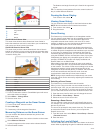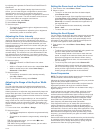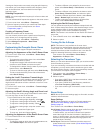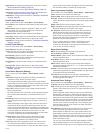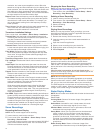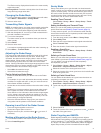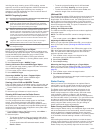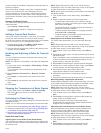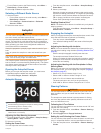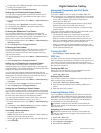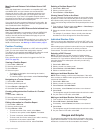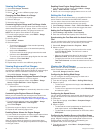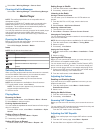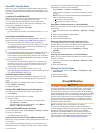
Reducing the gain to eliminate side-lobe interference may
cause smaller or distant targets to blink or disappear from the
Radar screen.
Adjusting Sea Clutter on the Radar Screen Automatically
You can set the chartplotter to automatically adjust the
appearance of clutter caused by choppy sea conditions.
NOTE: Depending upon the radar in use, the sea clutter setting
configured for use in one radar mode may or may not be applied
to other radar modes or to the radar overlay.
NOTE: Not all options and settings are available on all radar and
chartplotter models.
1
From a radar screen or the radar overlay, select Menu >
Noise Rejection > Sea Clutter.
2
Select Presets or Auto.
3
Select a setting that reflects the present sea conditions.
When using a compatible radar model, the chartplotter adjusts
the sea clutter based on the sea conditions automatically.
Adjusting Sea Clutter on the Radar Screen Manually
You can adjust the appearance of clutter caused by choppy sea
conditions. The sea clutter setting affects the appearance of
nearby clutter and targets more than it affects the appearance of
distant clutter and targets. A higher sea clutter setting reduces
the appearance of clutter caused by nearby waves, but it can
also reduce or eliminate the appearance of nearby targets.
NOTE: Depending upon the radar in use, the sea clutter setting
configured for use in one radar mode may or may not be applied
to other radar modes or to the radar overlay.
1
From a radar screen or the radar overlay, select Menu >
Noise Rejection > Sea Clutter.
2
Select Up or Down to adjust the appearance of sea clutter
until other targets are clearly visible on the radar screen.
Clutter caused by sea conditions may still be visible.
Adjusting Rain Clutter on the Radar Screen
You can adjust the appearance of clutter caused by rain.
Reducing the radar range also can minimize rain clutter
(Zooming In and Out of the Radar Screen, page 21).
The rain clutter setting affects the appearance of nearby rain
clutter and targets more than it affects the appearance of distant
rain clutter and targets. A higher rain clutter setting reduces the
appearance of clutter caused by nearby rain, but it can also
reduce or eliminate the appearance of nearby targets.
NOTE: Depending upon the radar in use, the rain clutter settings
configured for use in one radar mode may or may not be applied
to other radar modes or to the Radar overlay.
1
From a Radar screen or the Radar overlay, select Menu >
Noise Rejection > Rain Clutter.
2
Select Up or Down to decrease or increase the appearance
of nearby rain clutter until other targets are clearly visible on
the Radar screen.
Clutter caused by rain may still be visible.
Reducing Cross Talk Clutter on the Radar Screen
You can reduce the appearance of clutter caused by
interference from another nearby radar source, when the Cross
Talk Reject setting is on.
NOTE: Depending upon the radar in use, the crosstalk setting
configured for use in one radar mode may or may not be applied
to other radar modes or to the Radar overlay.
From a Radar screen or the Radar overlay, select Menu >
Noise Rejection > Crosstalk Rej..
Echo Trails
The echo trails feature enables you to track the movement of
vessels on the radar display. You can change the length of time
the trail is displayed.
NOTE: Depending upon the radar in use, the settings configured
for use in one radar mode may or may not be applied to other
radar modes or to the radar overlay.
NOTE: Not all options and settings are available on all radar and
chartplotter models.
Turning on Echo Trails
From a radar screen or the radar overlay, select Menu >
Radar Setup > Echo Trails > Display.
Adjusting the Length of the Echo Trails
1
From a radar screen or the radar overlay, select Menu >
Radar Setup > Echo Trails > Time.
2
Select the length of the trail.
Clearing the Echo Trails
You can remove the echo trails from the radar screen to reduce
the clutter the screen.
From a radar screen or the radar overlay, select Clear Trails.
Radar Display Settings
From any Radar screen or the Radar overlay, select Menu >
Radar Setup.
Orientation: Sets the perspective of the radar display. The
orientation setting applies to every radar mode. This setting
does not apply to the Radar overlay.
Appearance: Sets the color scheme, look-ahead speed, and
navigation appearance.
Front of Boat: Compensates for the physical location of the
radar scanner on a boat, if the radar scanner does not align
with the bow-stern axis.
Radar Appearance Settings
From a Radar screen, select Menu > Radar Setup >
Appearance.
NOTE: These settings do not apply to the Radar overlay.
Color Scheme: Sets the color scheme.
Look-Ahead Speed: Shifts your present location toward the
bottom of the screen automatically as your speed increases.
Enter your top speed for the best results.
Heading Line: Shows an extension from the bow of the boat in
the direction of travel on the radar screen.
Rings: Shows the range rings that help you to visualize
distances on the radar screen.
Nav Lines: Shows the navigation lines that indicate the course
you have set using Route To, Guide To, or Go To.
Waypoints: Shows waypoints on the radar screen.
Front-of-Boat Offset
The front-of-boat offset compensates for the physical location of
the radar scanner on a boat, if the radar scanner does not align
with the bow-stern axis.
Measuring the Potential Front-of-Boat Offset
The front-of-boat offset compensates for the physical location of
the radar scanner on a boat, if the radar scanner does not align
with the bow-stern axis.
1
Using a magnetic compass, take an optical bearing of a
stationary target located within viewable range.
2
Measure the target bearing on the radar.
3
If the bearing deviation is more than +/- 1°, set the front-of-
boat offset.
Setting the Front-of-Boat Offset
Before you can set the front-of-boat offset, you must measure
the potential front-of-boat offset.
The front-of-boat offset setting configured for use in one radar
mode is applied to every other radar mode and to the Radar
overlay.
24 Radar



